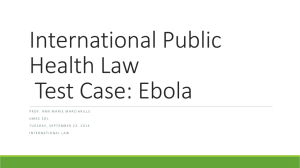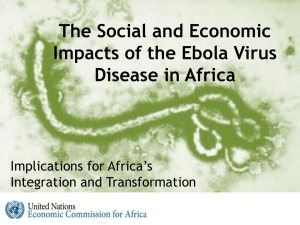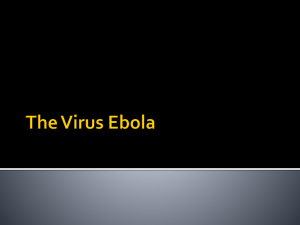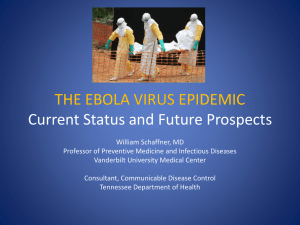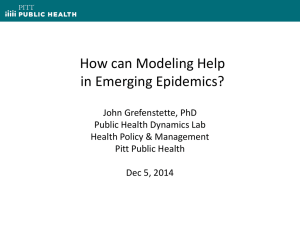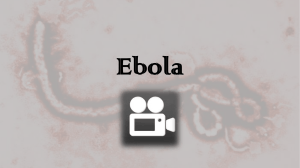Healthcare Personnel Preparedness for Ebola in New York
advertisement
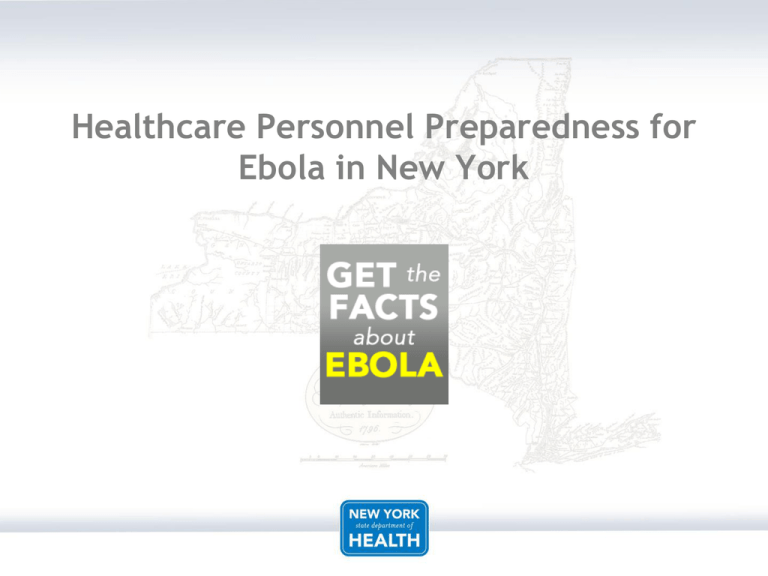
Healthcare Personnel Preparedness for Ebola in New York We Should All Be Ready • There’s no way to know or predict where a patient with Ebola might go • Every NY hospital must be ready to evaluate and isolate a patient who might have Ebola 1 Containing the Outbreak • Controlling Ebola in Africa is critical to protecting the rest of the world • Without interventions CDC estimates that by January 20, 2015, there could be 550,000 to 1.4 million Ebola cases in West Africa 2 Current Activities • Prevent health care worker illness: • DOH Commissioner’s Order requires all Article 28 clinics and hospitals have written protocols, provide equipment and training, and conduct drills • DOH has designated Ebola treatment center hospitals for the long term care of Ebola patients 3 Current Designated Treatment Centers • • • • • • • • Mt. Sinai in Manhattan New York Presbyterian in Manhattan Bellevue in Manhattan Montefiore in the Bronx North Shore/LIJ Health System in Nassau County Upstate University Hospital in Syracuse University of Rochester Medical Center in Rochester Stony Brook University Hospital on Long Island 4 What is Ebola? • A contagious virus typically found in rural Africa 5 What Are the Symptoms? • • • • • • • • Fever Severe headache Muscle pain Weakness Diarrhea Vomiting Abdominal pain (stomach) Unexplained hemorrhage (bruising or bleeding) 6 When Do Symptoms Occur? • Symptoms appear as soon as 2 days and as late as 21 days after being exposed to Ebola 7 How is Ebola Diagnosed? • Reliable blood test • CDC and several public health labs around the country (including NYS DOH and NYC DOHMH) 8 How is Ebola Spread? • Ebola spreads through direct contact of broken skin or mucous membranes with body fluids that contain the virus • Mucous membranes include the eyes, nose and mouth 9 Which Bodily Fluids Can Contain Ebola Virus? • • • • • • • • Blood Breast milk Feces Saliva Semen Sweat Urine Vomit 10 How Else Does Ebola Spread? • Needles and sharp instruments that are contaminated with the virus can also pose a risk of spread through needle sticks 11 How Ebola Doesn’t Spread • Ebola cannot be spread by people who don’t have any symptoms of illness • Ebola cannot be spread by breathing the same air as a patient with Ebola 12 Preventing the Spread of Ebola: What We Know More than Personal Protective Equipment • Hospitals must have thorough plans that cover all key aspects: • Early identification of possible cases • Safe care of infected patients • Cleaning of the environment • A good system for safe care is essential 13 Screening for Ebola: What to Ask • Ebola-related signs and symptoms • Contact in the past 21 days with either confirmed or suspect Ebola patients • Residence in—or travel to—an area where Ebola transmission is currently active including Liberia, Sierra Leone and Guinea 14 Safe Care for Ebola – What to Do 15 Safe Care 1 – Hand Hygiene • Contaminated hands are the most common way to transfer contaminated material to mucus membranes (eyes, mouth, nose) • Frequent cleaning with alcohol rub before, during and after care is critical 16 Safe Care 2 – Personal Protective Equipment New guidance reflects lessons learned: • Several groups have experience we can learn from • Specific recommendations for exactly what to wear and how can reduce the risk of exposure • Fewer options are preferable • Protective equipment should cover all skin surfaces • Extra layers or tape might make patient care and removal more difficult and increase the risk of contamination 17 Safe Care 2– Personal Protective Equipment with Masks or Respirators • CDC guidance gives options for respiratory protection – N95 – PAPR • Route of spread has not changed • Respirators provide protection in the event that an aerosol generating procedure has to be done unexpectedly 18 Safe Care 3 – Designated Areas • Clean and potentially contaminated areas must be clearly separated for putting on and taking off protective equipment 19 Safe Care 4 – Trained Observer • A trained observer should watch and help healthcare staff put on and take off protective equipment to ensure that good technique is followed every time • Don’t rush - this takes time 20 Safe Care 5 – Practice, Practice, Practice • Practice putting on and taking off protective equipment before patient care 21 Safe Care 6 – Limit Caregivers • Limit the number of healthcare personnel who come into contact with patients with Ebola 22 Safe Care 7 -- Disinfect • Daily cleaning of high touch surfaces can help reduce the risk of transmission – Daily cleaning should be done by members of the team providing patient care (e.g. physicians and nurses) • Immediately disinfect any equipment or surfaces that become visibly contaminated – Includes Personal Protective Equipment 23 What Works for Disinfection? • Alcohol based hand rubs • EPA-registered disinfectant wipes – Look for “non-enveloped viruses” on label • EPA-registered hospital surface disinfectants – Look for “non-enveloped viruses” on label 24 Cleaning the Room: After Discharge • After patient discharge, the room should be thoroughly cleaned in accordance with hospital procedures using an EPA registered hospital surface disinfectant effective against non-enveloped viruses • Cleaning personnel should follow the same protective equipment recommendations and need the same training • All linens, privacy curtains and non-fluid-impermeable cloth items should be discarded and not laundered 25 Waste Disposal • Staff trained to use Personal Protective Equipment correctly must handle waste carefully and follow protocols – – – – Used Personal Protection Equipment Cleaning wipes Microfiber cloths Linens 26 Know the Rules for Waste Disposal • Packaging and transport of Ebola waste is governed by DOT (federal) regulations, but the disposal is governed by state and local law • Ebola waste that has been appropriately incinerated, autoclaved, or otherwise inactivated is NOT infectious and is NOT considered regulated medical waste or hazardous material under Federal law 27 Waste Hauling • NEW for HOSPITALS: Wastes contaminated or suspected to be contaminated with Ebola virus must be packaged and transported in accordance with U.S. DOT Hazardous Materials Regulations • Contact your waste hauler to get necessary supplies and guidance, or contact DOT’s Pipeline and Hazardous Materials Safety Administration’s (PHMSA’s) Hazardous Materials Information Center at 1-800-467-4922, 9am-5pm Eastern time 28 Monitoring Healthcare Personnel • All healthcare personnel who enter the room of a patient with Ebola should be carefully monitored for 21 days after their last entry into the room • Healthcare personnel need to know exactly what to do and who to call if they develop symptoms 29 Key Points: Healthcare Facility Safety • Facility leadership provides resources and support for effective prevention precautions • Designated on-site Ebola site manager oversees precautions • Make sure there are clear, standardized procedures --Pick an option and have a back-up plan • Practice, practice, practice with the option you pick • Make sure there is oversight of practices and putting on and taking off of Personal Protective Equipment --Know what exposure looks like and stop and act if exposure occurs 30 DOH Ebola Website www.health.ny.gov Click on: 31 Thank You! Name Office of ___________ Name@health.ny.gov Tel: (123) 456-7890 Department of Health Corning Tower – ESP Albany, NY 12237


